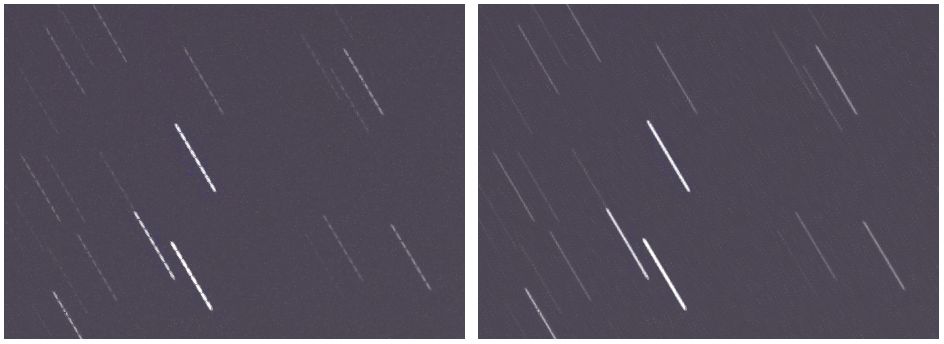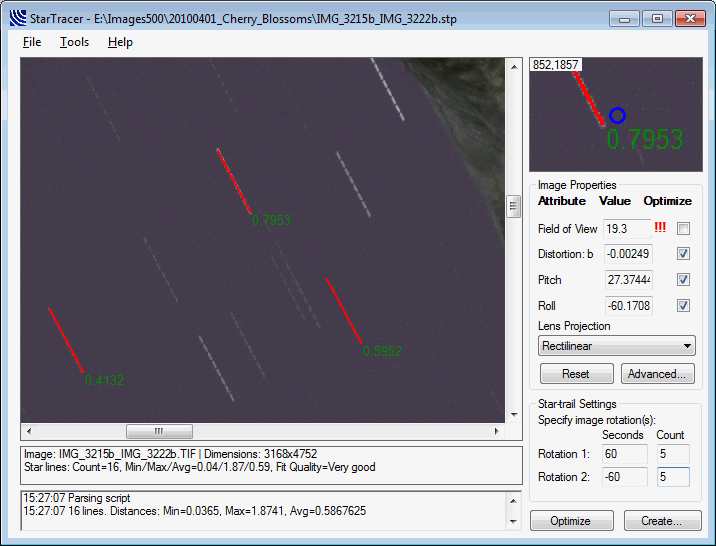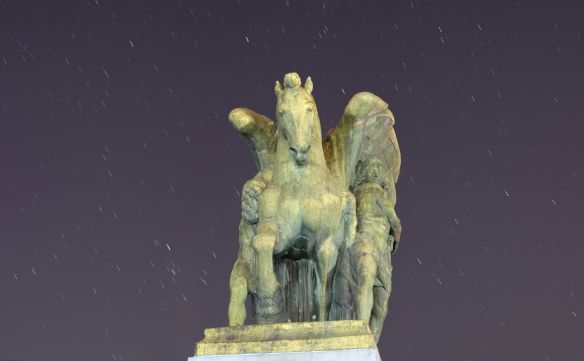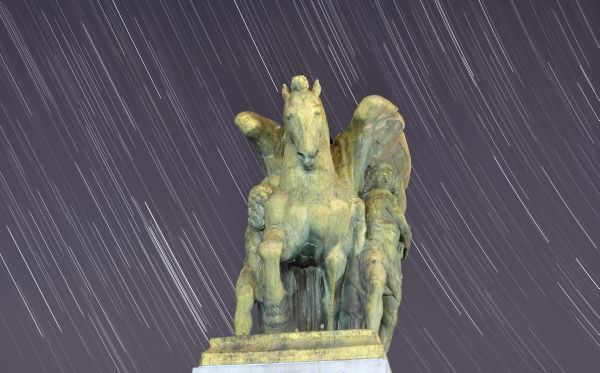
Filling the gaps...star-trails before (left) and after (right) processing with Star Tracer
Overview. Star Tracer is a Windows program that can be used to improve and enhance "star-trail" photographs. Its two main functions are:
Star Tracer works by calculating the path of the stars, and then using that information to either fill in the gaps and/or extend the length of star-trails.

Introduction. As the long-exposure capabilities of digital cameras have improved, they have become increasingly suitable for use in long-exposure "star-trail" photography, capturing the apparent motion of the stars across the sky as the Earth rotates. Star-trail images can be created by leaving the camera's shutter open for minutes or hours at a time. The longer the exposure, the longer the trails. A more flexible approach is to take a number of shorter exposures and then combine those images together using software to create a "synthetic" long exposure. Tawbaware's Image Stacker program makes this task very easy, and offers several blending modes to ensure that the sky does not appear over-exposed...something that can be problematic with star-trail images taken in a single long exposure.
One of the problems with the stacking approach is that most cameras typically pause for a short time between exposures. And, these pauses show up as "gaps" in the resulting stacked image. Even when using a remote-control device to automate the triggering of the shutter, most cameras pause for some period between exposures. And, many cameras perform "noise-reduction" immediately after capturing a long-exposure image, a process that can cause the camera to pause for several seconds before another image can be taken. Regardless of the reason why the camera pauses between exposures, the resulting stacked image often shows visible gaps. The image on the left above shows a stacked image consisting of 8 images taken with 12 second exposures. The camera paused for 3 seconds between each image, and these 3 second pauses appear as small gaps in the star-trails.

Gap Filling. Photographers have developed some techniques for minimizing and/or eliminating these gaps, but nothing really satisfactory that works well for a broad range of cameras, until now. Star Tracer can "fill in the gaps" in stacked images. It does this by calculating the trajectory of the stars and then using that information to precisely fill in the gaps. Gaps of any length can be filled using this technique...even if the gaps are larger than the individual trail segments themselves.
Star-trail Extension. A second use of Star Tracer is to extend the length of star-trails in any star-trail image. Once Star Tracer has computed the trajectory of the stars, it is a simple matter to extend the trails left by the stars.


How it Works. Conceptually, there are two main steps in using Star Tracer. The first main step is providing enough information to Star Tracer so that it can determine the path of the stars. This is done by drawing several "star lines" on the image. These lines tell Star Tracer about the path followed by individual stars in your image. Star Tracer uses this information to "optimize" the project...determining the trajectory of all the stars in the image. Even short star-trails (e.g. 60 seconds) contain enough information for Star Tracer to determine the trajectory that the stars will take over the course of several hours.
The second main step is creating the output image. Once the project has been optimized, Star Tracer can "rotate" the image by any amount and any number of times requested. You can choose to output the result as a single image, a series of images or a multi-layer Photoshop file.
Documentation. Star Tracer offers many more features than described here. The complete Star Tracer documentation (with additional screenshots) is available here.
Download Here. Download Star Tracer
Purchase and License Details. Star Tracer is shareware...meaning you are expected to "register" it (i.e. pay a small amount) to purchase the program. Before it has been registered, Star Tracer places several small watermarks on the images it creates, but no other restrictions/limitations are imposed. You can purchase a registration license code for Star Tracer on-line. Star Tracer is currently in public beta testing. During this period, the license price is discounted by 25% compared to regular price.
Contact. Please find contact details on
Tawbaware's homepage.